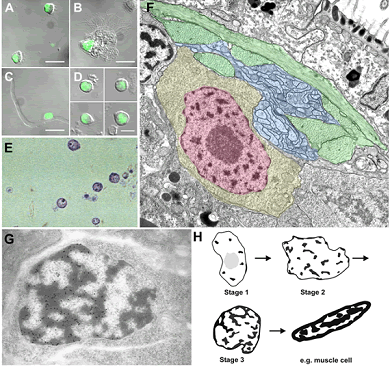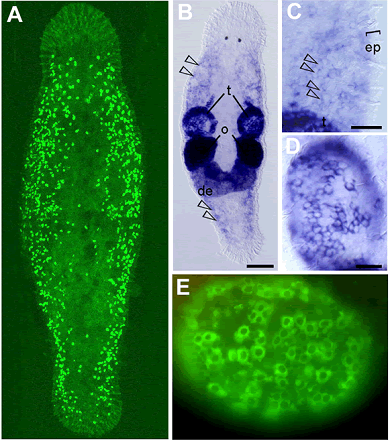
Regeneration and neoblasts
(Contributed by Peter Ladurner)
M. lignano possesses a substantial regenerative capacity. An amputated head regenerates the posterior part within 10 days but a posterior part of M. lignano does not regenerate a new head. A single individual has been shown to regenerate the posterior part including the gonads over 59 consecutive amputations from the remaining stem cells. These stem cells - called neoblasts - are thought to be totipotent and can give rise to all cell types including the gonads.

Figure 1. Neobalsts in M. lignano labelled with 30 min BrdU and after maceration of the animals into single cells (A-D) or histological staining (E). (F) ultrastructure of neoblast with nucleus (red) and small cytoplasm. (G) immunogold labelled neobalst. (H) schematic drwartings of different neblast stages.
Neoblasts can be identified by their small size (6-10 μm in diameter) and high nuclear/cytoplasmic ratio (Fig. 1). They possess a thin rim of cytoplasm containing free ribosomes, few mitochondria, and little endoplasmic reticulum. In M. lignano, live neoblasts can be observed in squeeze preparations using differential interference contrast microscopy. S-phase cell labelling can be applied by simply soaking the animal in the BrdU solution to label and trace lateral nerve cords but lack in the region anterior to the eyes and along the midline. The total cell number of cells of the animal is about 25,000, of which 1,600 are neoblasts, 400 are S-phase cells, and 25 in mitosis. Based on the ultrastructure the cytoplasm and the nuclear structure three types of neoblasts could be distinguished. More than 89% of the cycling neoblasts propagate from S-phase into mitosis within 24 hours. There are indications for quiescent neoblasts which are non-cycling for a 14 days period.
Animals show a high plasticity. Starvation for up to three months leads to degrowth and animals acquire the morphology of hatchlings. After prolonged feeding stem cells repopulate and restore all tissues and organs. During tissue homeostasis about one third of all cells are renewed after 14 days. The M. lignano stem cell system exhibits a high radiation tolerance. A single exposure up to 200 Gy was not sufficient to eliminate all stem cells. A fractionated radiation protocol was established to generate stem cell-free animals. Sublethal irradiation doses revealed that stem cells are restricted to lateral compartments.

Figure 2. (A) Immunocytochemical staining after 30 min BrdU labeling by soaking. (B-D) Piwi expression in somatic stem cells (arrowheads) and testes (t) and ovaries (o). (C) detail of expression in somatic stem cell. (D) detail of expression in testes. (E) Macpiwi protein in testis.

